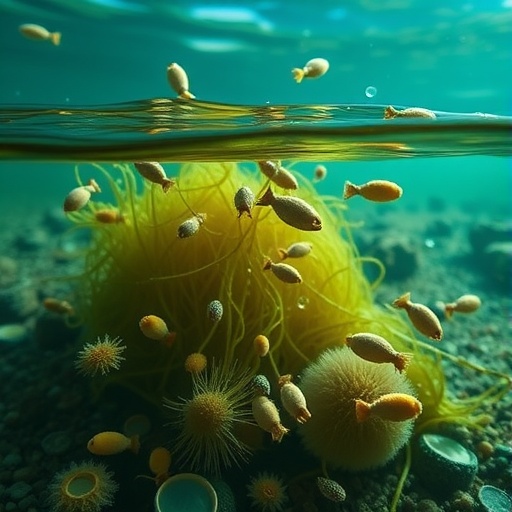In a groundbreaking study published in the journal Commun Earth Environ, researchers have unveiled a significant discovery concerning magnetosome gene clusters within bacteria found in oxygen-stratified freshwater ecosystems located in northern landscapes. This research, led by Ji, R., Wan, J., and He, K., opens a new avenue of understanding regarding microbial life in these unique environments.
Magnetosomes are organelles that allow certain bacteria to orient themselves along the Earth’s magnetic field, providing them with remarkable advantages in locating optimal environments for growth and survival. This behavior is crucial in oxygen-stratified ecosystems, where different levels of oxygen can dictate the types of organisms that thrive. The findings of this study underscore the adaptive mechanisms these bacteria employ in response to their oxygen-rich or oxygen-poor surroundings.
The research team conducted extensive sampling in various freshwater habitats across northern landscapes, focusing on areas where distinct oxygen gradients are present. Such habitats are often overlooked, yet they harbor a diverse range of microbial inhabitants. The presence of magnetosome gene clusters in these bacteria suggests that they possess unique genetic capabilities to navigate and thrive in the physically and chemically diverse environments found in these ecosystems.
One of the notable aspects of this study is the emphasis on the interplay between environmental factors and the genetic expressions of these microbes. The researchers meticulously documented the variations in magnetosome gene clusters among different bacterial species, providing evidence that the genetic basis for magnetosome production can significantly differ in response to environmental stimuli. This could lead to new insights into how microorganisms adapt to changing conditions, a topic that is of paramount importance in the face of global climate change.
Moreover, this research illuminates the potential applications of magnetobacteria in various fields, including biotechnology. The inherent magnetic properties these bacteria exhibit can be harnessed for a range of applications, from bio-remediation to novel drug delivery systems. The innovative nature of this study paves the way for further exploration into how we can utilize these microorganisms for practical benefits while contributing to our understanding of ecological dynamics.
Investigations into the adaptive strategies employed by these bacteria reveal complex signaling pathways that impact gene regulation. The study indicates the presence of specific regulatory mechanisms that coordinate the expression of magnetosome-related genes under varying oxygen conditions. Understanding these mechanisms could unravel the evolutionary history of magnetotactic bacteria, aiding scientists in pinpointing critical evolutionary shifts that have allowed these organisms to occupy their ecological niches successfully.
The findings about these gene clusters also raise intriguing questions regarding the wider implications for environmental microbiology. The capacity of magnetotactic bacteria to inhabit different layers of stratified water bodies adds depth to our understanding of aquatic ecosystems. This study could initiate new research directions aimed at uncovering the relationships between microbial communities and their surroundings in similar stratified environments across the globe.
Furthermore, the implications of such research extend to the realms of conservation and ecological management. Understanding the genetic adaptations of microbial life serves as a crucial aspect of recognizing how ecosystems respond to environmental changes. Such knowledge is vital for developing informed strategies aimed at preserving biodiversity in freshwater systems that are increasingly influenced by anthropogenic factors.
In conclusion, the groundbreaking research led by Ji, R., Wan, J., and He, K. sets the stage for a new chapter in the study of magnetotactic bacteria and their genetic adaptations to oxygen gradients in northern freshwater ecosystems. These findings not only enhance our scientific understanding but also spur potential practical applications that could revolutionize various sectors reliant on microbial technologies. As our world continues to face significant environmental challenges, studies like this are essential in providing newfound knowledge and innovative solutions.
The attention now turns to future studies looking to expand upon these findings. Exploring diverse geographic locations, assessing the impacts of climate change, and investigating potential industrial applications will provide a well-rounded comprehension of magnetotactic bacteria and their crucial role in sustaining life within our ecosystems.
By investing in further research, scientists can continue to unravel the complexities of these organisms and their environments, demonstrating how even the smallest life forms can have profound implications for our planet’s ecological balance. This fresh perspective on microbial ecosystems will undoubtedly fuel ongoing curiosity, leading to exciting discoveries in microbial ecology and the unexplored potentials residing within these tiny organisms.
Subject of Research: Magnetosome gene clusters in bacteria within oxygen-stratified freshwater ecosystems.
Article Title: Magnetosome gene cluster containing bacteria in oxygen-stratified freshwater ecosystems of northern landscapes.
Article References:
Ji, R., Wan, J., He, K. et al. Magnetosome gene cluster containing bacteria in oxygen-stratified freshwater ecosystems of northern landscapes.
Commun Earth Environ 6, 644 (2025). https://doi.org/10.1038/s43247-025-02495-8
Image Credits: AI Generated
DOI: 10.1038/s43247-025-02495-8
Keywords: magnetosome, bacteria, freshwater ecosystems, gene clusters, oxygen stratification, microbial adaptation, environmental microbiology.




